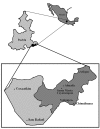Plant management and biodiversity conservation in Náhuatl homegardens of the Tehuacán Valley, Mexico
- PMID: 24195962
- PMCID: PMC3827996
- DOI: 10.1186/1746-4269-9-74
Plant management and biodiversity conservation in Náhuatl homegardens of the Tehuacán Valley, Mexico
Abstract
Background: The Tehuacán Valley is one of the areas of Mesoamerica with the oldest history of plant management. Homegardens are among the most ancient management systems that currently provide economic benefits to people and are reservoirs of native biodiversity. Previous studies estimated that 30% of the plant richness of homegardens of the region are native plant species from wild populations. We studied in Náhuatl communities the proportion of native plant species maintained in homegardens, hypothesizing to find a proportion similar to that estimated at regional level, mainly plant resources maintained for edible, medicinal and ornamental purposes.
Methods: We analysed the composition of plant species of homegardens and their similarity with surrounding Cloud Forest (CF), Tropical Rainforest (TRF), Tropical Dry forest (TDF), and Thorn-Scrub Forest (TSF). We determined density, frequency and biomass of plant species composing homegardens and forests through vegetation sampling of a total of 30 homegardens and nine plots of forests, and documented ethnobotanical information on use, management, and economic benefits from plants maintained in homegardens.
Results: A total of 281 plant species was recorded with 12 use categories, 115 ornamental, 92 edible, and 50 medicinal plant species. We recorded 49.8 ± 23.2 (average ± S.D.) woody plant species (shrubs and trees) per homegarden. In total, 34% species are native to the Tehuacán Valley and nearly 16% are components of the surrounding forests. A total of 176 species were cultivated through seeds, vegetative propagules or transplanted entire individual plants, 71 tolerated, and 23 enhanced. The highest species richness and diversity were recorded in homegardens from the CF zone (199 species), followed by those from the TRF (157) and those from the TDF (141) zones.
Conclusion: Homegardens provide a high diversity of resources for subsistence of local households and significantly contribute to conservation of native biodiversity. The highest diversity was recorded in homegardens where the neighbouring forests had the least diversity, suggesting that management of homegardens aims at compensating scarcity of naturally available plant resources. Cultivated species were markedly more abundant than plants under other management forms. Diversity harboured and management techniques make homegardens keystones in strategies for regional biodiversity conservation.
Figures







References
-
- Kumar BM, Nair PKR. The enigma of tropical homegardens. Agrofor Syst. 2004;61:135–152.
-
- Budowski G. Agroforistería: una diciplina basada en el conocimiento tradicional. Rev Forestal Centroamericana. 1993;2:14–18.
-
- Lok R. Lok R (ed) Huertos Caseros Tradicionales de América Central: Características, Beneficios e Importancia, Desde un Enfoque Multidisciplinario. Turrialba, Costa Rica: Centro Agronómico Tropical de Investigación y Enseñanza (CATIE); 1998. El huerto casero tropical tradicional en América Central; pp. 7–28.
-
- Nair PKR, Kumar BM. In: Tropical Homegardens: A Time-Tested Example of Sustainable Agroforestry. Kumar BM, Nair PKR, editor. Dordrecht, The Netherlands: Springer; 2006. Introduction; pp. 1–10.
Publication types
MeSH terms
LinkOut - more resources
Full Text Sources
Other Literature Sources

